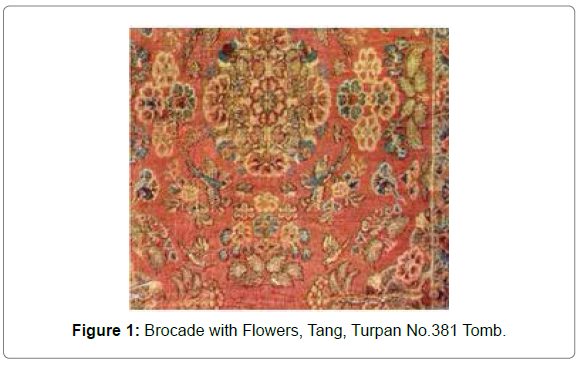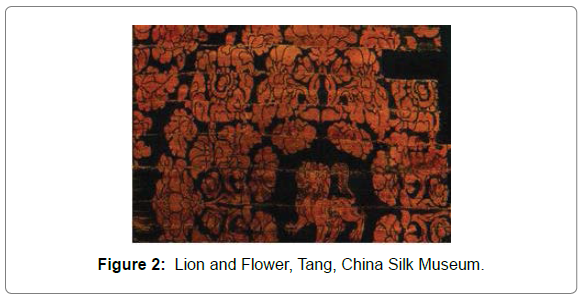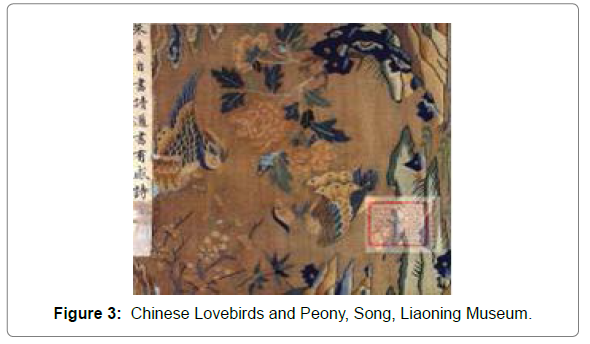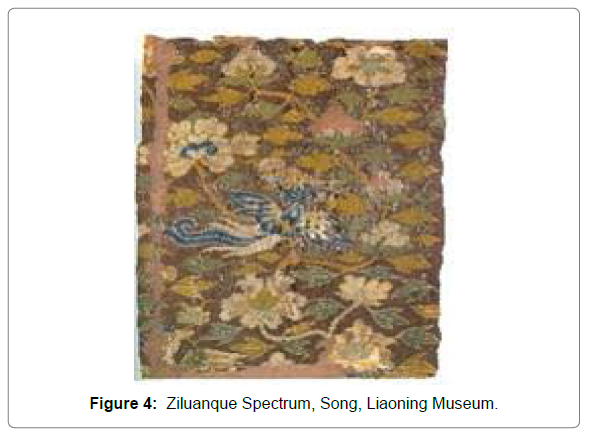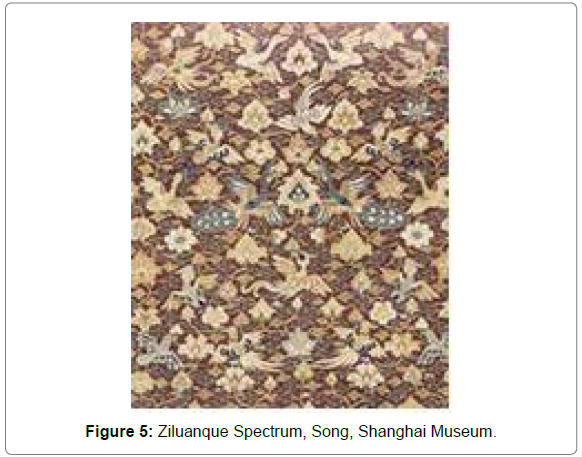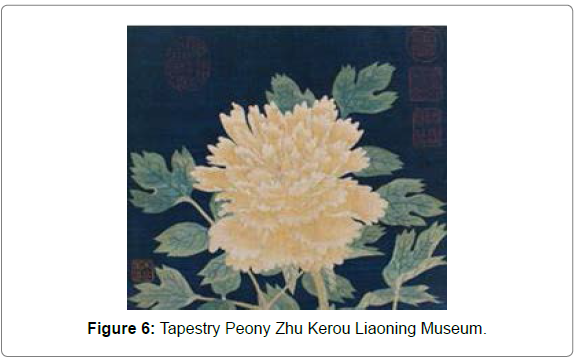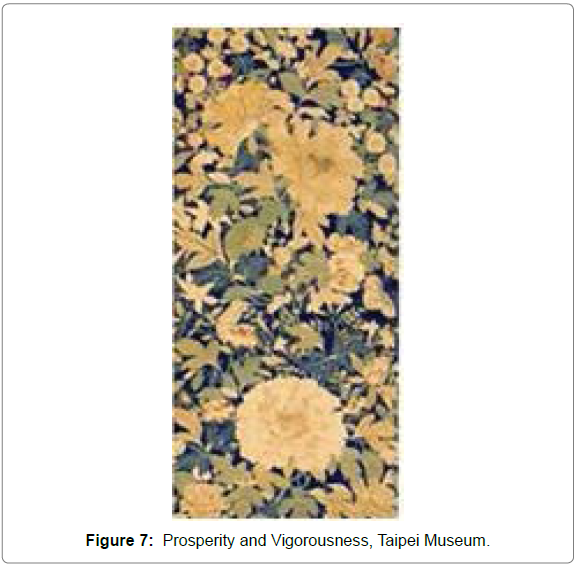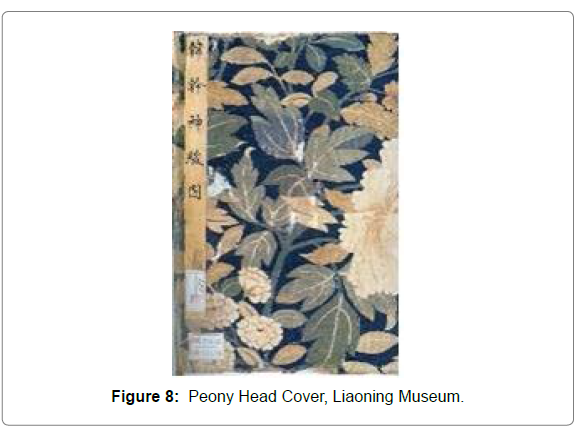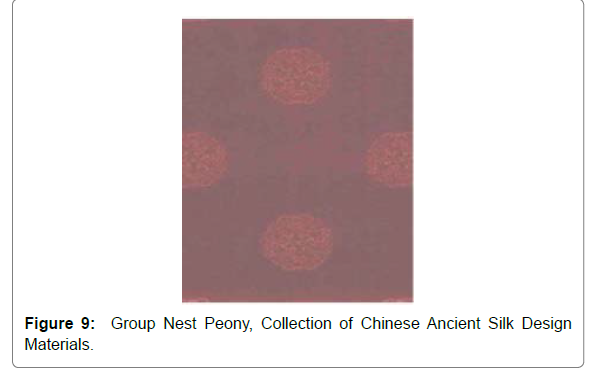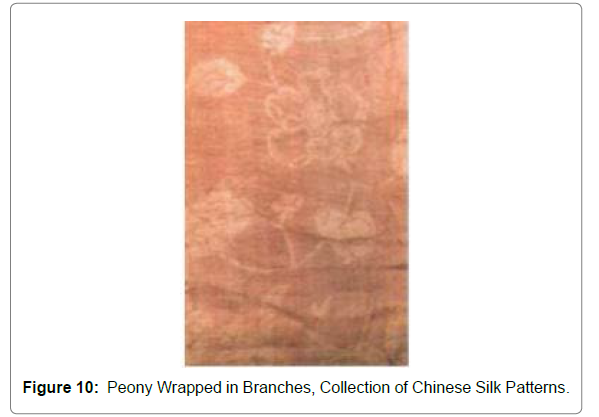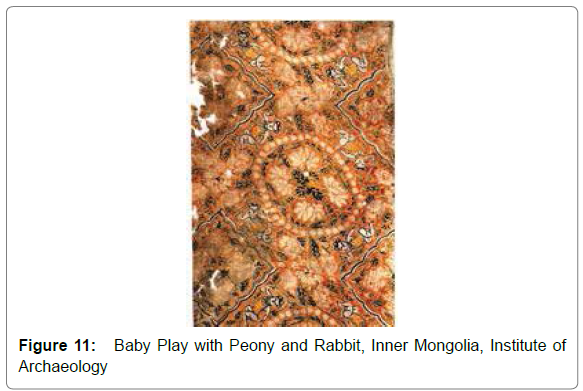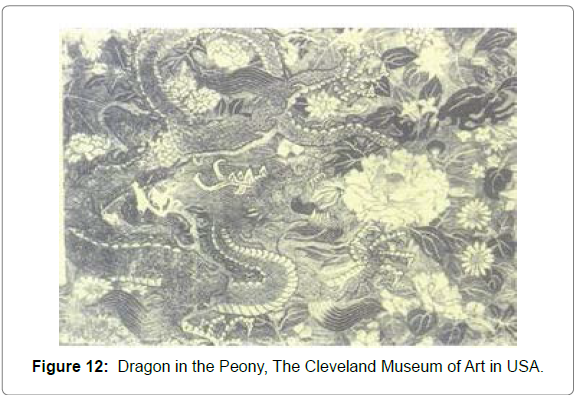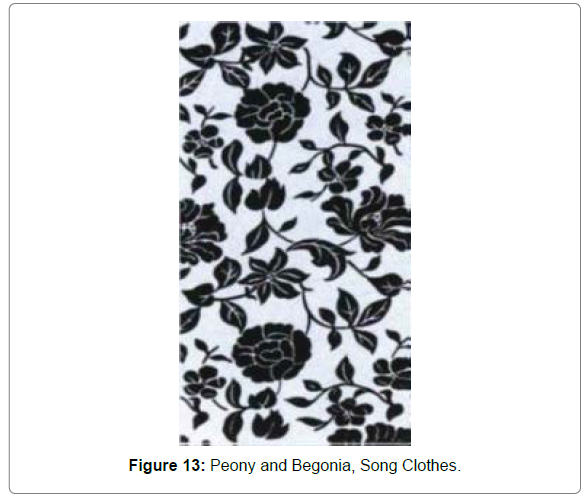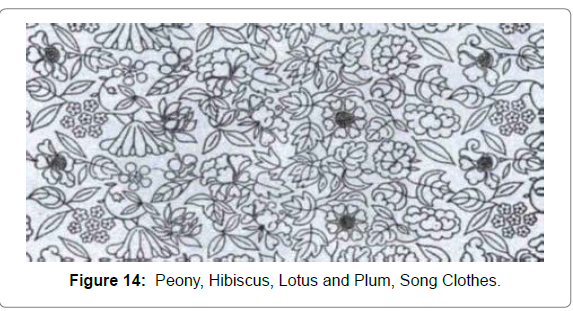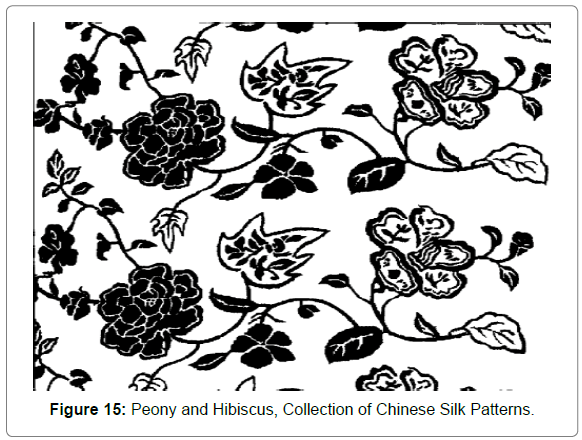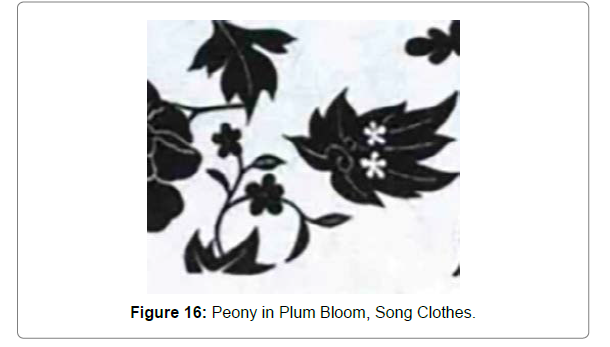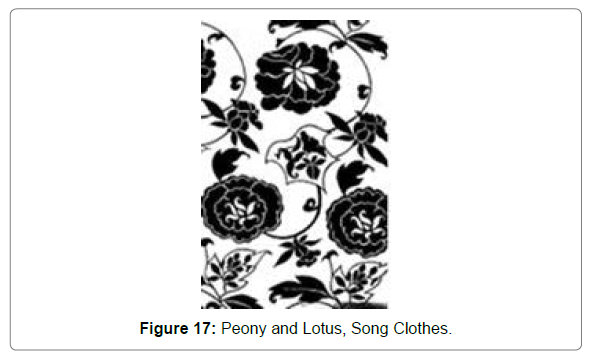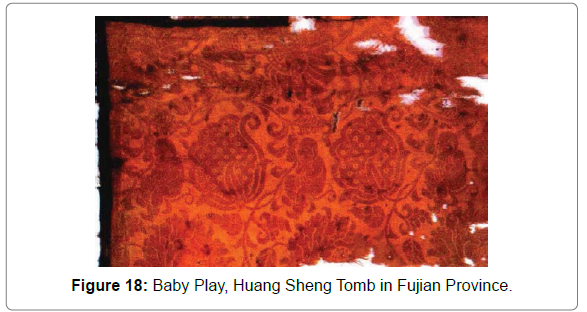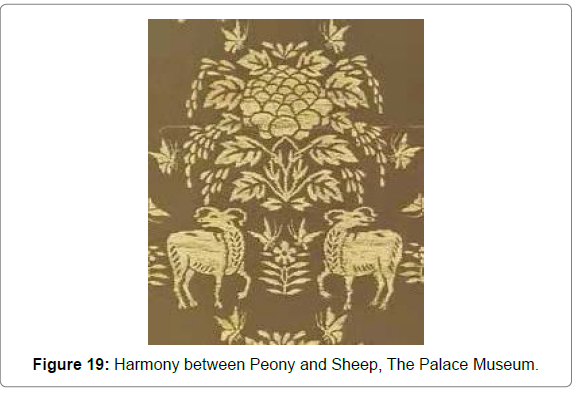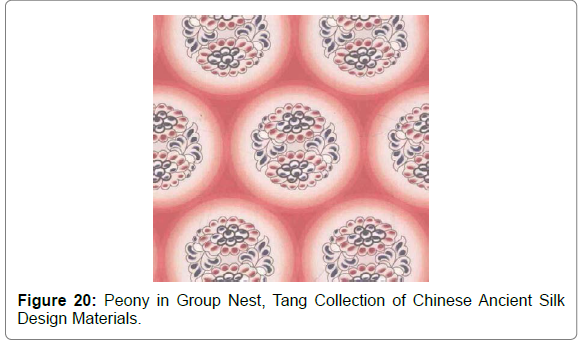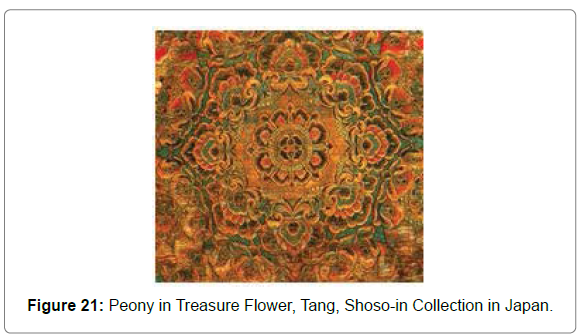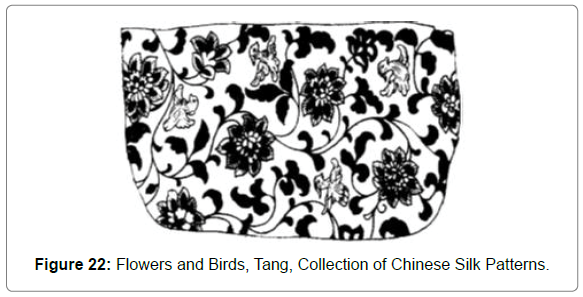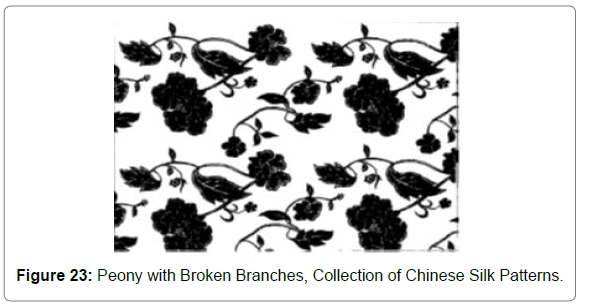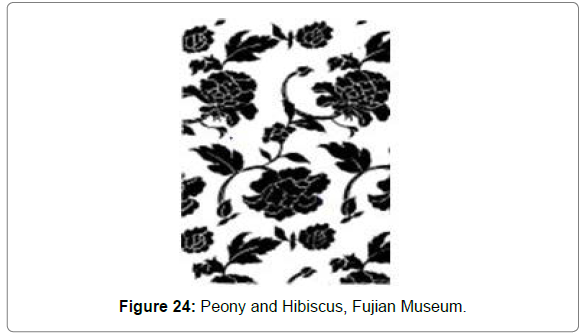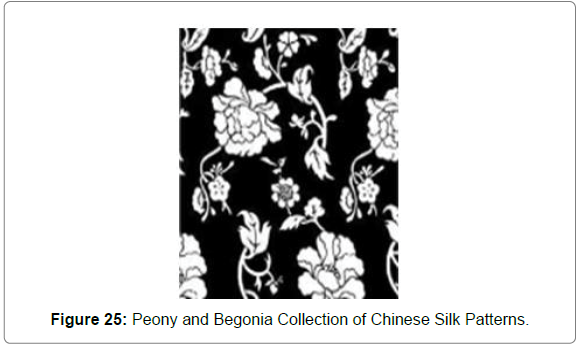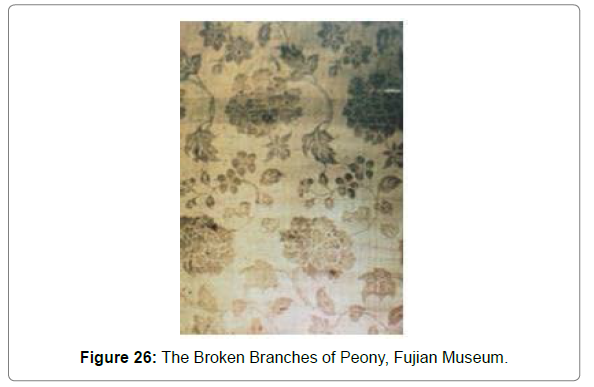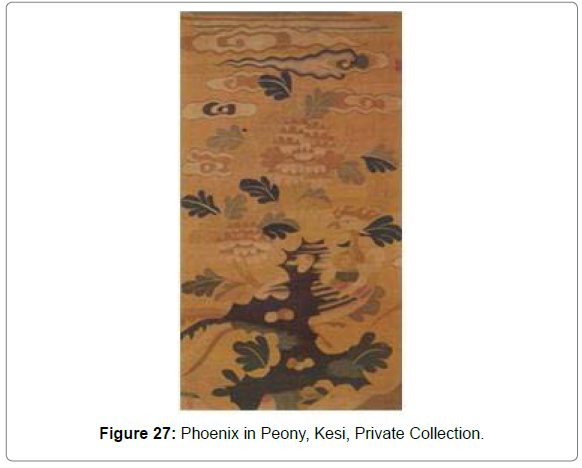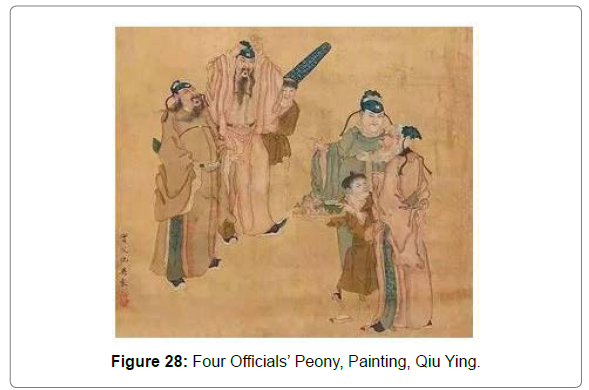Expert Review, J Fashion Technol Textile Eng Vol: 9 Issue: 11
Aesthetic Features of Peony Pattern in Chinese Silk in the Song Dynasty
Kangfu Zhang1, Naraindra Kistamah2* and Mingduan Fu1
1College of Fashion and Technology, Zhejiang Sci-Tech University, Hangzhou, China
2Departments of Applied Sustainability and Enterprise Development, Faculty of Engineering, University of Mauritius, Reduit, Mauritius
- *Corresponding Author:
- Naraindra Kistamah
Departments of Applied Sustainability and Enterprise Development, Faculty of Engineering, University of Mauritius, Reduit, Mauritius
E-mail: dharma@uom.ac.mu
Received Date: October 29, 2021; Accepted Date: November 22, 2021; Published Date: November 29, 2021
Citation: Zhang K, Kistamah N, Fu M (2021) Aesthetic Features of Peony Pattern in Chinese Silk in the Song Dynasty. J Fashion Technol Textile Eng 9:10. 230. Volume 9
Copyright: © All articles published in Journal of Journal of Fashion Technology & Textile Engineering are the property of SciTechnol, and is protected by copyright laws. Copyright © 2020, SciTechnol, All Rights Reserved.
Abstract
Compared with the bold and unrestrained aesthetics of the Tang Dynasty, the social aesthetics in the Song Dynasty tend to more introverted and elegant and the cultural elements of auspiciousness, blessing, good fortune, prosperity and joyfulness become the characteristics of silk design and color. This article discusses color, theme and the cultural features of peony silk pattern in the Song Dynasty, and points out that the peony pattern in the Song Dynasty focuses on purity and gradual discoloration, and the overall tone tends to be light and soft. In the Song Dynasty, the designers inherited the pattern of the single flower and group flower from the Tang Dynasty, while the winding flower pattern developed into a new popular form of broken branch flower. The pattern tends to be decorative with exquisite details, representing wealth and elegance. In addition, the peony pattern integrates the theme of goodness and beauty, elegance and popularity. All these aesthetic features and cultural connotation of silk patterns show the national prosperity and individual happiness in the Song Dynasty, which reveals the inherent relationship between design and culture.
Keywords: Aesthetic features; Peony pattern; Chinese silk; Song dynasty
Introduction
The Song Dynasty (960-1279) which included the Northern Song Dynasty (960-1127) and the Southern Song Dynasty (1127- 1279), lasted for 319 years. The culture of the Song Dynasty showed great development in civilization and reached an unprecedented level in cultural achievements, which consequently makes it act as a significant link between the preceding and the following dynasties in the history of Chinese culture. The first emperor Zhao Kuangy in initiated the policy of literary governance and a large number of intellectuals became government officials through the imperial examination system. The Song Dynasty was a period of great development of Confucianism and Neo-Confucianism in China. The ideological trend of emphasizing literature and neglecting military force began to spread in China, and the cultural mentality began to turn from expansion to introversion. “To excel in study and become an official” became the lifelong pursuit of literati, and the status of literati in the Song Dynasty has been unprecedentedly promoted. The Song dynasty prospered politically, economically and culturally and consequently a large number of famous literati, calligraphers and artists appeared. In song dynasty, literature developed in an all-round way, with remarkable achievements in poetry, Ci and prose. Many literary masters appeared, such as Ouyang Xiu, Su Shi, Wang Anshi, Li Qingzhao and so on. In art, the tendency of introspection and literati led to the prosperity of literati painting and flower-and-bird painting, especially the Song Dynasty painting academy founded by Zhao Ji, the emperor Huizong of the Song Dynasty, which played a huge role in promoting flower-and-bird painting. The Chinese historian Chen Yinke1 believes that “the culture of the Chinese nation has evolved over thousands of years and prospered in the Song dynasty”. The Scholar Wang Zengyu once pointed out that “the civilization in the Song Dynasty is superior to the Tang civilization in education, classics, science and technology, history, poems and prose.” Some foreign scholars also speak highly of the culture of the Song Dynasty. The Japanese historian Miyazaki Ishitu compared the culture of the Song Dynasty with the European Renaissance in his book Oriental Modern Times, and believed that “the European Renaissance is surely influenced by the Chinese culture of the Song Dynasty “. The British scholar John Toynbee2 once said, “If I had a choice, I would live in the Song Dynasty of China”.
Peony is a very important kind of flower in China. Since the Tang Dynasty (618-907), peony has been regarded as the king of flowers. The peony pattern in Chinese silk originated from the Kaiyuan period of Tang Dynasty (712-741). As the symbol of wealth and good fortune, peony is always used to represent national beauty and heavenly fragrance. In the Song Dynasty, the artists devoted themselves to reflecting naturalness and freshness in art and literature, and opened a new aesthetic style. Ouyang Xiu3 and Su Shi4 wrote poems and proses to praise beauty and pleasure from peony. In Ouyang Xiu’s Luoyang Peonies and LuoYang Peony Pictures, he attributed the peony aesthetic development in the Song Dynasty to the public’s craze for peony. The Story of Peony written by Su Shi also highlights the joy that the peony brings to the public. His poems“An old lady doesn’t feel shy of wearing peony in her hair, while peony should be shy to run on her head” exaggerates this kind of happiness. Egan Ronald [1], an American Sinologist, pointed out: “What is truly incredible is not the Luoyang residents’ enthusiasm for peony, but the intellectuals’ behavior of being intoxicated by the joy in appreciating and recording peonies.” There appeared several centers for peony plantation and sightseeing including the cities of Luoyang, Heze and Hangzhou. Consequently, peony frequently appeared in the different patterns of Chinese silk. The obsession of the public with peony resonated with the passion of artists’ creative imagination in their works. From the upper class to the ordinary family, people tend to link peony with prosperity, good fortune and peony is not only a flower in the nature, it is symbolized with different cultural meanings and enter people’s lives. The paper will discuss the color, theme as well as the aesthetic features of peony pattern in Chinese silk in the Song Dynasty to reveal the inherent relationship between design and culture.
The Development of Peony Colors and Product Appearance
Features of Peony Patterns in the Tang Dynasty
In the early Tang Dynasty (618-907), peony patterns were not frequently shown in textile design, sometimes shown only as decoration. During the Kaiyuan Period, peony patterns became rich and popular and the function changed from being decorative to realistic. In Figure 1, Brocade with Flowers, the large cluster of flowers in the center represents the embryonic form of a blooming peony surrounded by four phoenixes. The pattern is intermixed with some broken branch flowers and other small flowers. The main colors are true red, pink and golden, along with the ornamental colors of green and blue, the tone of whole pattern seems bright and rich. In Figure 2 Lion and Flower, a lion is standing among flowers, the shape of the flowers is like peony and the bud is like pomegranate. The color of the flower branches and leaves are bright, although there are only two colors in the whole pattern, yet from the flower cluster and lion pattern, the luxury of the heyday is fully reflected. The similarities between Figures 1 and 2 lie in the color purity, with true red, golden yellow as main colors to reflect the aesthetic taste in brightness and prosperity in the Tang Dynasty [2].
The Development of Peony Colors in the Song Dynasty
There appeared a new tendency in the aesthetic expression of peony in the Song Dynasty due to the development of the cultural environment and fabric technology. The obvious changes are as follows:
Weakening of Color Purity: In the Song Dynasty, color purity is significantly weakened. As is shown in Figure 3, Chinese Lovebirds and Peony the pattern is woven with Kesi technology5 to imitate the painting style in the Song Dynasty and this type of pattern is often used as book cover to decorate the valuable books. The color purity is obviously lower than that of the Tang Dynasty. The cool colors such as blue-green are intensified and the proportion of ink color is added, which makes the pattern harmonious and peaceful.
In Figure 4, the colors tend to be elegant and the flowers are in different forms so as to be more vividly expressed. In Figure 5, besides peony, there are other flowers including passion flower, lotus and begonia and the birds of swan goose, Luan bird, peacock, mandarin duck, caragana etc. are added.
The birds are in five pairs and lined symmetrically, the birds’ mouths with ganoderma lucidum. The background color changes from warm red to ochre, the brightness of flowers is emphasized and the purity is reduced, which makes the tone tender and refined [3].
Trend of Blue-Green Tones: The designers in the Song Dynasty used to imitate the famous works of calligraphy and paintings in the process of their artistic design. Figure 6, Tapestry Peony, presents the famous brand peony Yao Huang. This famous Kesi silk tapestry is the reproduction of the Song Court painting and this is the reason why it is still in good shape after a thousand years and regarded as another existence of the Song Court painting. This pattern focuses on a single flower with simple theme and composition. The petals show the skill of diminishing halo, which reflects the natural and beautiful shape and different layers of the petals. The grayish leaves and blue background create a green tone; the overall color is bright and composed, highlighting the fresh and elegant features. This pattern has a high artistic value with the unified color tone, exquisite and rich color performance. In Figures 8 and 9, the peony pattern is in green hue. Figure 7 shows a single pattern of Kesi technology with fresh and rich colors, the beauty and vitality of four-season flowers reveal people’s expectations for eternal wealth and fortune. The color is given priority to peony, with lotus, rose, chrysanthemum given the supplement colors. The petal edge is woven in a red silk thread and the double petal adopts the “de-halos” skill to better the color bit by bit, which reflects the delicate color change of the peony petals and highlights the symbolic meanings of vigorousness and longevity. Figure 9 depicts the application of Figure 7 in book packaging. In the Song Dynasty, Kesi pattern was often used in packaging the precious books and documents as gifts for friends or for private collection. When Kesi pattern is used in decoration, only a part of the original pattern is chosen. As a book cover, Figure 8 is a part of pattern of Figure 8 and the enlarged proportion conveys the prominent blue green tone.
Application of Peony Patterns in Clothes Design: In the Song Dynasty, the practical application of the peony pattern developed. In Figure 9, Group Nest Peony with scarlet as background color, the whole pattern seems exquisite. It is a type of high-grade fabric used in cassock or other formal dresses. In the pattern, two peonies bloom symmetrically in the nest, with a pair of flowers on each side as a foil. The large fleshy pink petals hook out and turn outward to show the change of layers. In Figure 10, Peony Wrapped in Branches, the fabric is satin with thin texture and transparent quality. The overall color purity is low with dark background and bright flowers. This pattern looks soft and beautiful and is used in women’s clothing. Figure 11, Baby Play with Peony and Rabbit, shows a silk pattern popular with common people, in which peony symbolizes wealth, baby means the offspring, rabbit implies reproduction and ribbon represents official career. All these elements show the Song people’s desire of good luck and longevity.
In China, dragon is the symbol of power, so the combination of peony and dragon is often used in the clothes pattern of the royal family. In Figure 12, Hundred Flowers Binding Dragon, the collision of dragon and flower diminishes the terror and power of the dragon. Instead, it highlights the aesthetic impression and adds taste and fun to the pattern. The low color purity and cold grey tone make the whole pattern more elegant. The whole pattern looks complete in harmony with nobleness and exquisiteness [4].
Evolution of Theme and Form of Peony Pattern in the Song Dynasty
Theme Evolution
In the Song Dynasty, the peony pattern became complex and the themes were characterized with integration, reflection and expansion. Integration refers to the combination of peony with other flowers or the auspicious animals. In Figure 13, Peony and Begonia, peony is the main flower and begonia is the secondary flower in bright and dark background. This is a very popular pattern in clothes and even well accepted nowadays. Figure 14, Peony, Hibiscus, Lotus and Plum includes flowers of four seasons, among which peony stands for wealth, hibiscus stands for glory, lotus signifies continuity and plum represents strength. The flower combination is mainly based on the Chinese pronunciations and the relevant connotations. For example, hibiscus in Chinese is a homonym for “rong”, symbolizing prosperity and glory, while begonia takes its homophonic “hall” as a symbol of family unity.
The second feature in the theme of peony pattern is reflection, in which the skills of grafting, implantation and hollowing are used. In Figure 15, peony is the main flower and supplemented by hibiscus, implying prosperity and wealth. The flowers of gardenia and camellias are grafted to the big flowers and leaves, implying endless life. In Figure 16, Peony in Plum Bloom, the plum is inserted into peony by the skills of grafting and cutting to symbolize wealth and honor. The plum blossoming on the peony leaves shows the effect of superposition and also its color echoes with the ground color. Figure 17, Lotus at the Heart of Peony, shows people’s reconsideration of wealth. Lotus appears in the heart of peony flower with the hope of combining sanctity and wealth, which shows the self-reflection of the Song people and revealed the aesthetic taste and religious culture of the era. The third feature of peony pattern theme is expansion or innovation, as shown in Figure 18, Baby Play. The designer combines peony with baby and litchi to express the theme of family prosperity and blessing for children and grandchildren. In the pattern, the peony in full blossom symbolizes good luck, while litchi means the hope for the offspring as in Chinese lichi has the homonym of ‘zi’ (children). Also, the baby’s posture of climbing adds fun and shows his good health, the bracelets on his wrist represent wealth and his parents’ expectations.
Form Evolution
The peony pattern in silk in the Tang Dynasty includes three forms: single flower, group flower and winding flower. Many patterns of single flower are used in Kesi or brocade with the complicated manufacturing process and high price. So, these patterns are suitable for making small expensive gifts such as purse, shoe and belt decoration. There is one famous type of single flower pattern of Ling Yang Gong Pattern6.
Figure 19, Harmony between Peony and Sheep is a kind of Ling Yang Gong style in the Tang Dynasty. The scholars call this as pattern of flower trees and sheep, in which peony is the flower tree in the middle with butterflies and flowers scattering around, two happy sheep under the flower tree are symmetrical, dynamic and lively [5]. Group flower is another form in the Tang Dynasty. Figure 20, Peony in Group Nest is the pattern of female dress in imitation of the painting of ‘Ladies Wearing Flowers’. The background color is bright red, and the gradient color shows the halo effect. In the nest, two large full bloom peonies form a group, with the peony petals in the double colors of black and scarlet. Figure 21 is decorative cover of a Chinese musical instrument Pipa. As the main element of group flower, the peony is full in shape, gorgeous in color and exquisite in craftsmanship. Figure 22, Flowers and Birds is a winding flower pattern with the decorative effect, in which the flower head is prominent and the twig is intertwined, there are some birds flying between the flowers and leaves. In the Tang Dynasty, such winding flower patterns are rarely seen except used in the decorative objects. When it came to the Song Dynasty, the designers inherited the pattern of single flower and group flower from the Tang Dynasty, yet these two forms tend to be less popular.
The winding flower pattern developed into a new popular form in the Song Dynasty, which is called the broken branch flower. As the artists in the Song Dynasty often observed nature and sketched the flowers, they used to present flowers with fresh and natural beauty in their creations. Generally, the flower head, branches and leaves are used as the basic elements to design a natural and fresh broken branch flower. The flower head and folded branch is usually rotated in the form of S or C. Then, the scattered points pierce through the branches in the invisible bones, so the pattern has an echoing result, developing a flexible and elegant form. In Figure 23, Peony with Broken Branches, there are two flowers with broken branches, arranged in different directions. The branches and leaves of the big flower are prominent, lush, while the small one appears natural and lovely. Figure 24, Peony and Hibiscus is fresh and natural; petals are more expressive and real. The buds on the branchlets point to the main flower and the thinner stems of the branches are interspersed with the small flowers, responding to the buds. In Figure 25, Peony and Begonia, the broken branches of the peony flowers are in the form of “C”, two branches are arranged symmetrically in one group and in reverse structure, forming an “S” with equal space arrangement. The begonia branches come out from the peony branches and leaves to reveal the freshness and naturalness. In Figure 26, The Broken Branches of Peony, the main flower peony is large and prominent, and the supplementary flowers are beautiful and exquisite, which form a complete silk pattern of broken branch flowers.
As shown in Figures 23-26, the techniques of replacement and transplantation are used in the broken branch patterns to express the ornamental features and achieve the artistic effect of flowers in the flowers, leaves in the leaves as well as the interaction between people and flowers.
Aesthetic Features of Peony Patterns in the Song Dynasty The aesthetic culture of peony began at the Kaiyuan Period of the Tang Dynasty and further developed in the prosperous and peaceful Song Dynasty [6]. The Song people showed their cultural confidence and romantic feelings in the artistic works of poems, proses and silk designs. As to the peony pattern, the connotations of national prosperity and royal power combined with the symbolic features of gentleness, elegance, morality and faithfulness reflected the cultural requirements of people from the different walks of life.
Flower King’s Prosperity and Nobleness
In Chinese history, many artists show their interest and passion towards peony in their literary and artistic works. Zhang Yi, the author of “Hua Jing” (Scripture of Flowers)7, divided all the flowers into nine hierarchies, among which peony ranked the first. The peony is named as “Hua” (Flower) in Chinese, while the other flowers can only be called by their specific names to show the honorable position of the peony. Consequently, peony was identified as flower king, together with the symbols of national beauty and elegance. In the Song Dynasty, peony frequently appeared as flower king in the poems of the famous literati officials. In Han Qi’s8 poem Appreciation of Peony in The North of Zen, “peony is depicted as the color of spring and the flower king”. In one poem of Fan Zhongyan’s9, there is a line “Let alone the flower King and the Imperial Palace”. Shao Yong10 linked the flower king of peony with national prosperity and regarded the image of blooming peony as the sign of peaceful prosperity in the Song society. Some officials linked the image of peony with the national destiny and the royal virtues; there appeared the artistic theme of using peony as the ode to the imperial power. Consequently, this universal recognition of peony as flower king develops an aesthetic craze and such cultural phenomenon prevails during the Song Dynasty.
In the silk patterns, peonies and emperors, peonies and officials are the frequently used themes to signify prosperity and nobleness. Figure 27 is named as Phoenix in Peony. Phoenix is a kind of holy bird in China and stands for the image of the empress while dragon symbolizes the emperor.
This type of pattern is still used in cheongsam or bedclothes for the newlyweds. Figure 28, Four Officials’ Peony, is connected with an allusion in the Song Dynasty (Dream Pool Essays by Shen Kuo). Han Qi planted the peony of Golden Daiwei, when four flowers bloomed at the same time; he invited three friends to appreciate the flowers and gave a piece of Golden Daiwei as gift to each of them. These four men later all became the prime ministers of the Song Dynasty. Four Officials’ Peony originally is a famous painting in the Ming Dynasty (1368-1644), depicting the four prime ministers dressed in peony pattern clothes.
Unity of Virtue and Appearance
During the Song Dynasty, there are two trends in peony aesthetics.
The first is the development of aesthetic taste and quality. Bede, a commonly used complimentary remark in ancient China, compares the quality of human beings with the attributes of the natural objects to achieve the harmony between people and nature. The natural objects are endowed with emotion and morality and become the spiritual mimicry of human being. Bede is used to compare the peony with human beings’ nobleness and dignity and this is the reason why the overall tone of peony pattern changes from the colorful brightness to the refined elegance. Shao Yong points out that ‘the beauty of flowers lies in the spirit... All colors show innocence’, which reflects the aesthetics values in flowers and people’s spiritual pursuit of the good virtues. In Han Qi’s Self-expression of National Flower, the quality of calmness, elegance became symbolic of the peony. Su Shi’s poem of Blossom in Coldness Speaks Freedom reflected the quality of human beings’ dignity and self-respect. All the cultural athletics of peony can be seen from the silk patterns; the peony form and color seem elegant with the mild and delicate tone, which symbolizes the pursuit of elegance, freedom and self -reflection in the Song cultural aesthetics [7].
Reflection of Mass Enjoyment in Peaceful Time
Due to the economic prosperity and social stability, a culture of mass enjoyment prevailed in the Song Dynasty. People used to enjoy the present prosperity and pray for the future peacefulness. Such cultural development has an impact on the peony pattern with a variety of joyful elements. The appearance of high rank officials in the silk patterns shows the peony popularity in the upper class. The officials often related peony beauty with the national prosperity and hope for peace and safety, and peony often appeared in their ode to the royal power. In addition, some officials still retain the inner desires of romance and freedom. Ou Yangxiu linked the flourishing peonies with the beautiful memory of passing youth. Sima Guang11 had the famous lines to See Peony of Yao Huang in Wet Clothes. After the Southern Song dynasty moved to the south part of China, there raised a new tendency of reclusion in the literati because of the dissatisfaction with the social reality. They turned to floral imagery to recall the past beautiful memories and reflected their desires for enjoyment in reclusion amid the political turmoil, for which there was no better subject than peony. As to the common people, the atmosphere of prosperity in the carpe dime dominated and the Song people cherished and enjoyed the present life. This kind of enjoyment can be seen in the peony silk patterns and this also means that peony can be a common entertainment between the common people and people from the upper class. To some degree, this is a symbol of peacefulness and stability of the Song Dynasty.
Conclusion
Among the silk patterns in the Song Dynasty, the peony pattern focuses on the color purity and the overall tone tends to be light and soft. The color tends to be more decorative with the exquisite details and the theme emphasizes on prosperity, auspiciousness and elegance. In the Song Dynasty, the designers inherited the pattern of the single flower and group flower from the Tang Dynasty, while the winding flower pattern developed into a new popular form of broken branch flower, in which the techniques of replacement and transplantation are used to express the ornamental effect.
The Song Dynasty witnessed rapid economic development and the diversified cultural development. The silk industry both in scale and production capacity and technology have been greatly improved, laying a solid foundation for the development of silk design. Compared with the bold and unrestrained aesthetics of the Tang Dynasty, the social aesthetics in the Song Dynasty tend to more introverted and elegant. At the same time, the mass cultural elements were added to the design and color culture, and the auspicious culture based on household blessing and the joyfulness began to emerge, gradually becoming one of the characteristics of silk design and color. All these aesthetic features and cultural connotation of silk patterns show the national prosperity and individual happiness in the Song Dynasty, which reveals the inherent relationship between design and culture.
1Chen Yinke (1890 -1969) Chinese historian, scholar of classical literature, linguist and poet.
2John Toynbee (1889 -1975) English historian and was widely regarded as the greatest historian of modern times.
3Ouyang Xiu (1007 - 1072) statesman and the first literary leader of the Northern Song Dynasty.
4Su Shi (1037 - 1101) statesman and a literary leader in the middle of the Northern Song Dynasty.
5Kesi or Chinese silk tapestry, also known as "cutting silk", is the essence of traditional Chinese silk artwork. It is the most traditional way to pick the warp and show the weft in China's silk weaving industry. It enjoys decorative silk fabrics and has been one of the imperial fabrics since the Song and Yuan Dynasties.
6Ling Yang Gong pattern is the traditional Chinese decorative patterns in Tang brocade with the symmetrical form structure.
7Scripture of Flowers includes 71 kinds of flowers, which are classified as "nine kinds of flowers and nine lives" according to their quality.
8Han Qi (1008-1075) statesman and poet in the Northern Song Dynasty.
9Fan Zhongyan (989-1052) statesman, strategist, litterateur and educator in the Northern Song Dynasty.
10Shao Yong (1011 -July 5), famous Neo-Confucianist, mathematician and poet in the Song Dynasty.
11Sima Guang (1019 -1086), statesman, historian, writer in the Song Dynasty.
References
- Egan R (2008) The Problem ofBeauty: Aesthetic Thought and Pursuits in Northern Song Dynasty China. Harv J Asiat Stud 68: 247-247.
- Jun-long F U (2007) On the View of" Bi De" in Chinese Ancient. In The Northern Forum : 4.
- Mingyuan G (2006) An analysis of the impact of traditional Chinese culture on Chinese education. Front Educ China 1: 169-190.
- Huang H (2012) Why Chinese people play Western classical music: Transcultural roots of music philosophy. Int J Music Educ 30: 161-176.
- Ding Ding (2008) The Position of Confucian Culture of Rituals and Music in Traditional Chinese Culture and its Modern Value. Confucius Studies 6:5-7.
- Hang Jian (2020) Meditation on Design. Art and Design 03: 8-12.
- Hong Shuhua (2015) Complex of Peony among Poems and Ci in Song Dynasty and Its Cultural Reading. Journal of Chong Qing University of Arts and Sciences 01:25-33.
 Spanish
Spanish  Chinese
Chinese  Russian
Russian  German
German  French
French  Japanese
Japanese  Portuguese
Portuguese  Hindi
Hindi 